In my last entry I wrote about how exciting it is to win a game that you were just hoping to draw. The outcome of this year’s U.S. Championship might end up being determined by just such a game.
Round nine. Varuzhan Akobian versus Fabiano Caruana. Akobian sacrificed two pawns for a nonexistent attack, and by move 50 Caruana had consolidated and was completely winning.
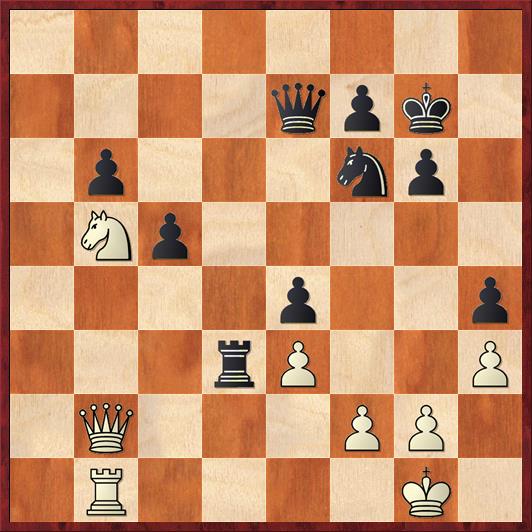 Position after 50. Rb1. Black to move.
Position after 50. Rb1. Black to move.
FEN: 8/4qpk1/1p3np1/1Np5/4p2p/3rP2P/1Q3PP1/1R4K1 b – – 0 50
The chess engines were showing Black with an advantage of 3.5 pawns. The broadcast team of Yasser Seirawan, Jennifer Shahade, and Maurice Ashley started looking at other games, assuming this one would be over soon.
But a funny thing happened. Akobian forgot to give up.
50. … Qe6?
In retrospect, this was the beginning of the worst collapse of the tournament, maybe one of the worst collapses ever by a 2800 player. The computer loves the move 50. … c4! for Black. As Seirawan said, this is a little bit counterintuitive because it gives White a great square for his knight with 51. Nd4. But one point is revealed after 51. … Qc5! 52. Qxb6?? Rd1+!
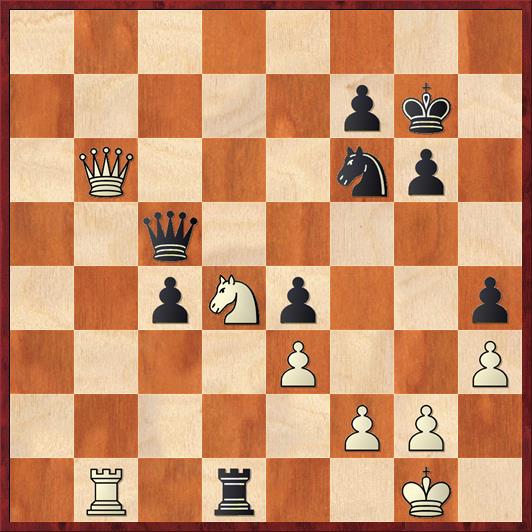 Position after 52. … Rd1+ (analysis). White to move.
Position after 52. … Rd1+ (analysis). White to move.
FEN: 8/5pk1/1Q3np1/2q5/2pNp2p/4P2P/5PP1/1R1r2K1 w – – 0 52
Yes, my friends, it’s the Hook and Ladder Trick! The same one that I wrote about for Chess Life. Of course, if 53. Rxd1 Qxb6 wins the queen, and if 53. Kh2 Qe5+ 54. g3 hg+ will be curtains soon.
Although I would love to say that Caruana lost this game because he didn’t read my article about the Hook and Ladder Trick, I can’t do that. Many other things had to happen.
What I’ll say is that this position requires an interesting combination of middle-game and end-game thinking. On the one hand, you have the Hook and Ladder Trick, which is definitely a middle-game type of combination, providing the tactical justification for giving up the b-pawn. On the other hand, 50. … c4 is very much an endgame sort of move. Black is saying to White that middle-game considerations (like giving the knight an outpost on d4) no longer matter because he is just going to play c3 and ram his extra pawns down White’s throat.
Also, another thing about this position is that if Black doesn’t want to risk the tactics, he could always just play 50. … Kh7 to unpin his knight. Then he will be able to play … Nd7, … Qe5, etc., maintaining a two-pawn advantage with almost no risk.
Instead I think what happened was that Caruana believed that he could give up the b-pawn for a favorable simplification. If so, it was poor judgment.
51. Nc7 Qd7 52. Qxb6 c4 53. Nb5 Rd1+ 54. Rxd1 Qxd1+ 55. Kh2 Qd5? 56. Nd4 …
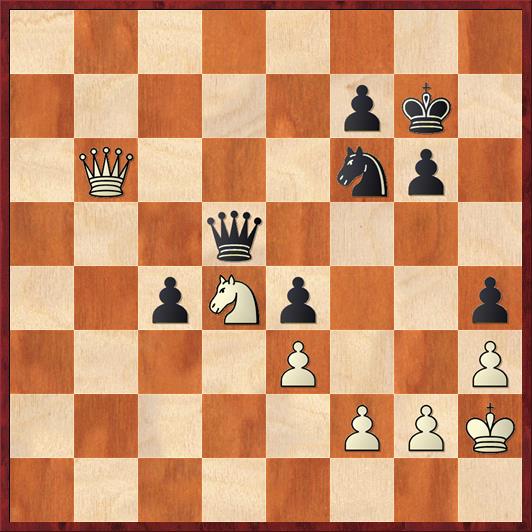 Position after 56. Nd4. Black to move.
Position after 56. Nd4. Black to move.
FEN: 8/5pk1/1Q3np1/3q4/2pNp2p/4P2P/5PPK/8 b – – 0 56
White has already made huge progress. He’s gotten his knight to the d4 outpost anyway, and only has to worry about one passed pawn on the queenside rather than two. It’s far from clear how Black is going to win this game. To promote the c-pawn he will have to get his knight involved somehow — which he tries to do at the next move, only to be instantly rebuffed. In fact, that is a big reason Black didn’t win this game — he never found a way to turn his knight into an active piece. Can we really say that Black has an advantage in material when he has, in effect, half a knight against White’s whole knight?
I want to say a little bit about the psychology of this type of position, which Akobian handled masterfully. You realize that you’re probably losing, but if you don’t see exactly how your opponent is going to win, chances are that he probably doesn’t see it either. And that puts enormous pressure on him. You have nothing to lose, while he’s the one who has to make all the hard decisions. All you have to do is keep putting up infinite resistance. Think of yourself as the brick wall, or the backboard that returns all of his volleys. Maybe your opponent will win, but to do it he is going to have to hit a tennis ball through a brick wall.
56. … Nd7 57. Qd8! …
Continuing to limit the mobility of the knight.
57. … Qd6 58. Kg1 c3 59. Kh1! …
Beautiful infinite resistance. White says to Black, with this setup of pieces your tennis ball will never get through my brick wall. You’ll have to try something different.
59. … Qd5 60. Kg1 Qb7
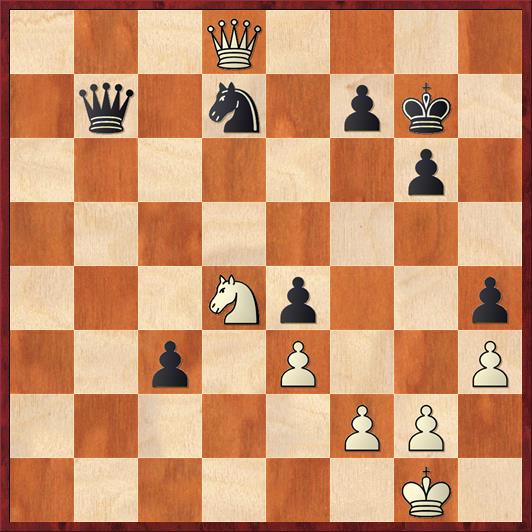 Position after 60. … Qb7. White to move.
Position after 60. … Qb7. White to move.
FEN: 3Q4/1q1n1pk1/6p1/8/3Np2p/2p1P2P/5PP1/6K1 w – – 0 60
Here Akobian made his one mistake. He now has the opportunity to convert “infinite resistance” into “ingenious swindle.”
These are really the two ways of defending a lost position: Either you grit your teeth and hold on forever, or you come up with some clever trick that gets you out of trouble in one fell swoop.
But here’s a secret: the ingenious swindle usually comes after a period of infinite resistance. When your opponent’s will to win has been weakened, when his clock is low, that’s when he is likely to miss your clever trick.
Do you see the clever trick that both Caruana and Akobian missed?
61. Qe7? …
Akobian could have ended the game immediately with 61. Nf5+! If Black takes the knight, 61. … gf, then it’s an instant repetition of position with 62. Qg5+. The alternative 61. … Kh7 62. Qxh4+ Kg8 63. Nh6+ is also a draw. The key for White is to play Qd8+ only after Black has played … Kf8, so that the knight can never interpose on f8.
As Seirawan pointed out, this is a very common perpetual-check pattern, and it’s surprising that Akobian didn’t see it. Ironically, if he had seen it, he would have only drawn the game instead of winning. Instead he continues putting up infinite resistance, and is rewarded beyond his wildest dreams.
I’ll fast-forward through the next 15 moves and get to the thrilling conclusion of the game.
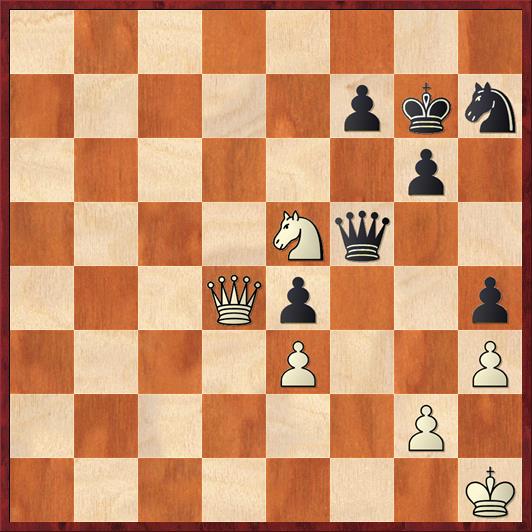 Position after 76. Qd4. Black to move.
Position after 76. Qd4. Black to move.
FEN: 8/5pkn/6p1/4Nq2/3Qp2p/4P2P/6P1/7K b – – 0 76
After 15 moves, Black has achieved less than nothing. He’s traded the passed c-pawn for the f-pawn. The knight on h7 continues to be a very sad animal, unable to find any route into activity. Not only is Black lacking threats, but he’s already facing some serious threats by White. There’s the discovered check to worry about. 76. … Nf6 would lose a pawn to 77. Ng4, followed by exchanging on f6 and taking on e4. 76. … Kg8 would lose a pawn to 77. Qd8+, followed by Qxh4. 76. … Kh6? would do worse than lose a pawn, as White is in a mating net after 77. Ng4+ Kh5 78. Qg7.
In fact, I think that Black’s position has become so bad that he should just play 76. … Nf6 and offer a draw. But this was psychologically impossible for Caruana. He had been two pawns up. He had been totally winning. Moreover, he needed a win badly in the tournament, to stay within striking distance of Wesley So, the tournament leader. And finally, he was in huge time pressure. Both he and Akobian were playing on the increment — in other words, they had less than a minute on their clocks and were relying on the 30 added seconds that they get each move.
And so Caruana leaped from the frying pan into the fire with 76. … f6?? The computer went crazy here, as the evaluation swung wildly between even and +6 for White. But there was no question in Akobian’s mind, as he swooped in for the kill with 77. Qa7+! Kh6 (if 77. … Kh8 78. Nf7+ Kg8 79. Nh6+ wins the queen) 78. Ng4+ Kg5 79. Qxh7 and Black resigned.
I think that most commentators will focus on how Caruana “blew” his huge advantage, but credit has to be given also to Akobian for not losing his cool. The finish was, of course, a gift of the chess gods to him, but he wasn’t as outrageously lucky as it appears. When you’re playing the strategy of infinite resistance, the clock is your secret weapon. Also, your opponent’s stubbornness and pride are another secret weapon. No one wants to draw a game where they were winning by two connected passed pawns, so they’ll keep pushing for a win past the time when objectively they should give it up. That’s when “infinite resistance” becomes “infinite punishment”!
P.S. By the way, this game made the last two rounds of the U.S. Championship a lot more interesting for the spectators. A draw or a win by Caruana would have put Wesley So in clear first place, and the way he’s been playing it’s very doubtful that anyone could catch him. But now, Akobian is tied with So at 6/9. I think that Akobian has a slightly more difficult schedule to finish, because he still has to play Nakamura in the last round. Nevertheless, who would have predicted that Akobian, the tenth seed out of twelve, would be tied for first going into the last two rounds?


